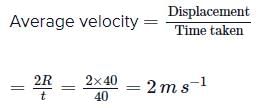All questions of Position-Time Graphs for Grade 9 Exam
The velocity of the particle at any time t is given by v = 2t(3 − t)m s−1. At what time is its velocity maximum?- a)2 s
- b)3 s
- c)2/3s
- d)3/2 s
Correct answer is option 'D'. Can you explain this answer?
The velocity of the particle at any time t is given by v = 2t(3 − t)m s−1. At what time is its velocity maximum?
a)
2 s
b)
3 s
c)
2/3s
d)
3/2 s
|
|
Hansa Sharma answered |
given v = 2t(3 − t) or v = 6t - 2t2

For V maximum or minimum

The position x of a particle with respect to time t along x-axis is given by x = 9t2 −t3. where x is in metres and t is in seconds. What will be the position of this particle when it achieves maximum speed along the + x direction?- a)54 m
- b)81 m
- c)24 m
- d)32 m
Correct answer is option 'A'. Can you explain this answer?
The position x of a particle with respect to time t along x-axis is given by x = 9t2 −t3. where x is in metres and t is in seconds. What will be the position of this particle when it achieves maximum speed along the + x direction?
a)
54 m
b)
81 m
c)
24 m
d)
32 m
|
|
Anjali Sharma answered |
Given: x = 9t2 − t3


for Maximum speed, dv/dt
= 0 ⇒ 18 - 6t = 0
∴ t = 3s.
∴ xmax = 81m - 27m
= 54 m. (From x = 9t2 - t3)
= 0 ⇒ 18 - 6t = 0
∴ t = 3s.
∴ xmax = 81m - 27m
= 54 m. (From x = 9t2 - t3)
A bird is tossing (flying to and fro) between two cars moving towards each other on a straight road. One car has speed of 27 km h−1 while the other has the speed of 18 km h−1. The bird starts moving from first car towards the other and is moving with the speed of 36 km h−1 when the two were separated by 36 km. The total distance covered by the bird is- a)28.8 km
- b)38.8 km
- c)48.8 km
- d)58.8 km
Correct answer is option 'A'. Can you explain this answer?
A bird is tossing (flying to and fro) between two cars moving towards each other on a straight road. One car has speed of 27 km h−1 while the other has the speed of 18 km h−1. The bird starts moving from first car towards the other and is moving with the speed of 36 km h−1 when the two were separated by 36 km. The total distance covered by the bird is
a)
28.8 km
b)
38.8 km
c)
48.8 km
d)
58.8 km
|
|
Ajay Yadav answered |

Velocity of car A, vA = +27kmh−1
Velocity of car B, vB = −18kmh−1
Relative velocity of car A with respect to car B
=vA − vB = + 27kmh−1 (−18kmh−1) = 45kmh−1
Time taken by the two cars to meet = 36 km/45 km h-1 = 0.8
Time taken by the two cars to meet = 36 km/45 km h-1 = 0.8
Thus, distance covered by the bird
= 36kmh−1 x 0.8h = 28.8km
= 36kmh−1 x 0.8h = 28.8km
The motion of a particle is described by the equation x = at + bt2 where a = 15 cm and b = 3 cm/sec2. Its instantaneous velocity at time 3 sec will be:
- a)33 cm s-1
- b)18 cms-1
- c)16 cm s-1
- d)32 cms -1
Correct answer is option 'A'. Can you explain this answer?
The motion of a particle is described by the equation x = at + bt2 where a = 15 cm and b = 3 cm/sec2. Its instantaneous velocity at time 3 sec will be:
a)
33 cm s-1
b)
18 cms-1
c)
16 cm s-1
d)
32 cms -1
|
|
Raghav Bansal answered |
here, x = at + bt2
Given a = 15 cm b = 3cm/sec-2

at t = 3 s, v = 15 + 2 x 3 x 3 = 33cm s-1
The area under velocity-time graph for a particle in a given interval of time represents- a)velocity
- b)acceleration
- c)work done
- d)displacement
Correct answer is option 'D'. Can you explain this answer?
The area under velocity-time graph for a particle in a given interval of time represents
a)
velocity
b)
acceleration
c)
work done
d)
displacement
|
|
Preeti Iyer answered |
The area under the velocity-time graph represents the displacement over a given time interval.
Which of the following statements are incorrect?
(i) Average velocity is path length divided by time interval.
(ii) In general, speed is greater than the magnitude of the velocity.
(iii) A particle moving in a given direction with a non-zero velocity can have zero speed.
(iv) The magnitude of average velocity is the average speed.- a)(ii) and (iii)
- b)(ii) and (iv)
- c)(i), (iii) and (iv)
- d)All four
Correct answer is option 'C'. Can you explain this answer?
Which of the following statements are incorrect?
(i) Average velocity is path length divided by time interval.
(ii) In general, speed is greater than the magnitude of the velocity.
(iii) A particle moving in a given direction with a non-zero velocity can have zero speed.
(iv) The magnitude of average velocity is the average speed.
(i) Average velocity is path length divided by time interval.
(ii) In general, speed is greater than the magnitude of the velocity.
(iii) A particle moving in a given direction with a non-zero velocity can have zero speed.
(iv) The magnitude of average velocity is the average speed.
a)
(ii) and (iii)
b)
(ii) and (iv)
c)
(i), (iii) and (iv)
d)
All four
|
|
Lavanya Menon answered |

A particle moving in a given direction with non-zero velocity cannot have zero speed. In general, average speed is not equal to magnitude of average velocity. However it can be so if the motion is along a straight line without change in direction.
Speedometer of a car measures- a)average speed
- b)average velocity
- c)instantaneous speed
- d)instantaneous velocity
Correct answer is option 'C'. Can you explain this answer?
Speedometer of a car measures
a)
average speed
b)
average velocity
c)
instantaneous speed
d)
instantaneous velocity
|
|
Mira Joshi answered |
Speedometer of the car measures the instantaneous speed of the car.
Speedometer measures the speed of the car in
- a)m s−1
- b)cm s−1
- c)km h−1
- d)km min−1
Correct answer is option 'C'. Can you explain this answer?
Speedometer measures the speed of the car in
a)
m s−1
b)
cm s−1
c)
km h−1
d)
km min−1
|
|
Raghav Bansal answered |
Speedometer measures the speed of the car in km h−1.
The position of an object moving along x-axis is given by x = a + bt2 , where a = 8.5 m and b = 2.5 m s−2 and t is measured in seconds. The average velocity of the object between t = 2 s and t = 4 s is- a)5 m s-1
- b)10 m s-1
- c)15 m s-1
- d)20 m s-1
Correct answer is option 'C'. Can you explain this answer?
The position of an object moving along x-axis is given by x = a + bt2 , where a = 8.5 m and b = 2.5 m s−2 and t is measured in seconds. The average velocity of the object between t = 2 s and t = 4 s is
a)
5 m s-1
b)
10 m s-1
c)
15 m s-1
d)
20 m s-1
|
|
Raghav Bansal answered |

6(2.5)m s-1 = 15m s-1
A bus is moving with a speed of 10ms−1 on a straight road. A scooterist wishes to overtake the bus in 100s. If the bus is at a distance of 1km from the scooterist with what speed should the scooterist chase the bus?- a)40 ms-1
- b)25 ms-1
- c)115 m s-1
- d)125 ms-1
Correct answer is option 'D'. Can you explain this answer?
A bus is moving with a speed of 10ms−1 on a straight road. A scooterist wishes to overtake the bus in 100s. If the bus is at a distance of 1km from the scooterist with what speed should the scooterist chase the bus?
a)
40 ms-1
b)
25 ms-1
c)
115 m s-1
d)
125 ms-1
|
|
Raghav Bansal answered |
Let vs be the velocity of the scooter, the distance between the scooter and the bus = 1000m,
The velocity of the bus = 10ms−1
Time taken to overtake = 100s
Relative velocity of the scooter with respect to the bus = (vs − 10)
1000/(vs − 10) = 100s
= vs = 20ms−1
A police van moving on a highway with a speed of 30km h−1 fires a bullet at a thief's car speeding away in the same direction with a speed of 192km h−1. If the muzzle speed of the bullet is 150ms−1 , with what relative speed does the bullet hit the thief's car?- a)95 ms-1
- b)105 m s-1
- c)115 ms-1
- d)125 m s-1
Correct answer is option 'B'. Can you explain this answer?
A police van moving on a highway with a speed of 30km h−1 fires a bullet at a thief's car speeding away in the same direction with a speed of 192km h−1. If the muzzle speed of the bullet is 150ms−1 , with what relative speed does the bullet hit the thief's car?
a)
95 ms-1
b)
105 m s-1
c)
115 ms-1
d)
125 m s-1
|
|
Mira Joshi answered |
Speed of police van w.r.t. ground
∴ vPG = 30kmh−1
Speed of thief’s car w.r.t. ground
∴ vTG = 192kmh−1
Speed of bullet w.r.t. police van

Speed with which the bullet will hit the thief’s car will be
vBT = vBG + vGT = vBP + vPG + vGT
= 540kmh−1 + 30kmh−1 − 192kmh−1
(∵ vGT = −vTG)


Two parallel rail tracks run north-south. On one track train A moves north with a speed of 54kmh−1 and on the other track train B moves south with a speed of 90kmh−1. The velocity of train A with respect to train B is- a)10 ms-1
- b)15 ms-1
- c)25 ms-1
- d)40 ms-1
Correct answer is option 'D'. Can you explain this answer?
Two parallel rail tracks run north-south. On one track train A moves north with a speed of 54kmh−1 and on the other track train B moves south with a speed of 90kmh−1. The velocity of train A with respect to train B is
a)
10 ms-1
b)
15 ms-1
c)
25 ms-1
d)
40 ms-1
|
|
Preeti Iyer answered |
Let the positive direction of motion be from south to north. Velocity of train A with respect to ground
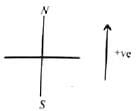


Velocity of train B with respect to ground

Relative velocity of train A with respect to train B is

A particle moves with uniform velocity. Which of the following statements about the motion of the particle is true?- a)Its speed is zero
- b)Its acceleration is zero
- c)Its acceleration is opposite to the velocity
- d)Its speed may be variable
Correct answer is option 'B'. Can you explain this answer?
A particle moves with uniform velocity. Which of the following statements about the motion of the particle is true?
a)
Its speed is zero
b)
Its acceleration is zero
c)
Its acceleration is opposite to the velocity
d)
Its speed may be variable
|
|
Suresh Iyer answered |
A particle moving with uniform velocity has zero acceleration.
Two cars A and B are running at velocities of 60 km h−1 and 45 km h−1. What is the relative velocity of car A with respect to car B, if both are moving eastward?- a)15 km h-1
- b)45 km h-1
- c)60 km h-1
- d)105 km h-1
Correct answer is option 'A'. Can you explain this answer?
Two cars A and B are running at velocities of 60 km h−1 and 45 km h−1. What is the relative velocity of car A with respect to car B, if both are moving eastward?
a)
15 km h-1
b)
45 km h-1
c)
60 km h-1
d)
105 km h-1
|
|
Anjali Sharma answered |
Velocity of car A w.r.t. ground
∴ vAG = 60 kmh−1
Velocity of car B w.r.t. ground
∴ vBG = 45 km h−1
Relative velocity of car A w.r.t. B
vAB = vAG + vGB
=vAG − vBG = 15 km h−1 (∵ vGB = −vBG)
The motion of a body is given by the equation dv/dt = 6 − 3v where v is the speed in m s−1 and t is time in s. The body is at rest at t = 0. The speed varies with time as- a)v = (1 − e−3t )
- b)v = 2(1 − e−3t)
- c)v = (1 + e−2t)
- d)v = 2(1 + e−2t)
Correct answer is option 'B'. Can you explain this answer?
The motion of a body is given by the equation dv/dt = 6 − 3v where v is the speed in m s−1 and t is time in s. The body is at rest at t = 0. The speed varies with time as
a)
v = (1 − e−3t )
b)
v = 2(1 − e−3t)
c)
v = (1 + e−2t)
d)
v = 2(1 + e−2t)
|
|
Riya Banerjee answered |

Integrating both sides, we get

where C is a constant of integration
At t = 0, v = 0



Two parallel rail tracks run north-south. On one track train A moves north with a speed of 54 kmh−1 and on the other track train B moves south with a speed of 90kmh−1. What is the velocity of a monkey running on the roof of the train A against its motion with a velocity of 18 kmh-1 with respect to the train A as observed by a man standing on the ground?- a)5 ms-1
- b)10 ms-1
- c)15 ms-1
- d)20 ms-1
Correct answer is option 'B'. Can you explain this answer?
Two parallel rail tracks run north-south. On one track train A moves north with a speed of 54 kmh−1 and on the other track train B moves south with a speed of 90kmh−1. What is the velocity of a monkey running on the roof of the train A against its motion with a velocity of 18 kmh-1 with respect to the train A as observed by a man standing on the ground?
a)
5 ms-1
b)
10 ms-1
c)
15 ms-1
d)
20 ms-1
|
|
Gaurav Kumar answered |
Let the velocity of the monkey with respect to ground be vMG
Relative velocity of the monkey with respect to the train A

Relative velocity of the monkey with respect to the train A

A ball A is dropped from a building of height 45 m. Simultaneously another identical ball B is thrown up with a speed 50 m s−1. The relative speed of ball B w.r.t. ball A at any instant of time is (Take g = 10 m s−2).- a)0
- b)10 m s-1
- c)25 ms-1
- d)50 ms-1
Correct answer is option 'D'. Can you explain this answer?
A ball A is dropped from a building of height 45 m. Simultaneously another identical ball B is thrown up with a speed 50 m s−1. The relative speed of ball B w.r.t. ball A at any instant of time is (Take g = 10 m s−2).
a)
0
b)
10 m s-1
c)
25 ms-1
d)
50 ms-1
|
|
Jyoti Sengupta answered |
Here, uA = −0 , uB = +50ms−1
aA = −g , aB = −g
uBA = uB − uA = 50ms−1 − (0)ms−1 = 50ms−1
aBA = aB − aA = −g − (−g) = 0
∵ vBA = uBA + aBAt(As aBA = 0)
∴ vBA = uBA
As there is no acceleration of ball B w.r.t to ball A, therefore the relative speed of ball B w.r.t ball A at any instant of time remains constant (= 50ms−1).
Figure shows the displacement (x) -time (t) graph of the particle moving on the x-axis.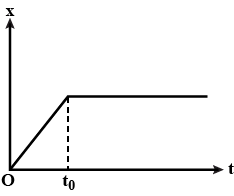
- a)The particle is at rest.
- b)The particle is continuously going in positive x-direction.
- c)The velocity of the particle increases upto time t0 and then becomes constant.
- d)The particle moves at a constant velocity up to a time t0 and then stops.
Correct answer is option 'D'. Can you explain this answer?
Figure shows the displacement (x) -time (t) graph of the particle moving on the x-axis.

a)
The particle is at rest.
b)
The particle is continuously going in positive x-direction.
c)
The velocity of the particle increases upto time t0 and then becomes constant.
d)
The particle moves at a constant velocity up to a time t0 and then stops.
|
|
Geetika Shah answered |
The displacement-time graph is a straight line inclined to time axis upto time t0 indicates a uniform velocity. After time t0, the displacement-time graph is a straight line parallel to time axis indicates particle at rest.
A train A which is 120m long is running with velocity 20m/s while train B which is 130m long is running in opposite direction with velocity 30m/s. What is the time taken by train B to cross the train A?- a)5 s
- b)25 s
- c)10 s
- d)100 s
Correct answer is option 'A'. Can you explain this answer?
A train A which is 120m long is running with velocity 20m/s while train B which is 130m long is running in opposite direction with velocity 30m/s. What is the time taken by train B to cross the train A?
a)
5 s
b)
25 s
c)
10 s
d)
100 s
|
|
Nabanita Chakraborty answered |
Understanding the Problem
To find the time taken by train B to completely cross train A, we need to consider both the lengths of the trains and their relative velocities.
Key Information
- Length of Train A: 120 m
- Length of Train B: 130 m
- Velocity of Train A: 20 m/s
- Velocity of Train B: 30 m/s
Relative Velocity Calculation
When two objects move in opposite directions, their relative velocity is the sum of their speeds.
- Relative Velocity = Velocity of Train A + Velocity of Train B
- Relative Velocity = 20 m/s + 30 m/s = 50 m/s
Total Distance to Cross
To find the total distance that train B needs to cover to completely cross train A, we add their lengths:
- Total Distance = Length of Train A + Length of Train B
- Total Distance = 120 m + 130 m = 250 m
Time Calculation
Using the formula for time, which is:
- Time = Total Distance / Relative Velocity
We can substitute the values:
- Time = 250 m / 50 m/s = 5 s
Conclusion
The time taken by train B to completely cross train A is 5 seconds.
Thus, the correct answer is option 'A'.
To find the time taken by train B to completely cross train A, we need to consider both the lengths of the trains and their relative velocities.
Key Information
- Length of Train A: 120 m
- Length of Train B: 130 m
- Velocity of Train A: 20 m/s
- Velocity of Train B: 30 m/s
Relative Velocity Calculation
When two objects move in opposite directions, their relative velocity is the sum of their speeds.
- Relative Velocity = Velocity of Train A + Velocity of Train B
- Relative Velocity = 20 m/s + 30 m/s = 50 m/s
Total Distance to Cross
To find the total distance that train B needs to cover to completely cross train A, we add their lengths:
- Total Distance = Length of Train A + Length of Train B
- Total Distance = 120 m + 130 m = 250 m
Time Calculation
Using the formula for time, which is:
- Time = Total Distance / Relative Velocity
We can substitute the values:
- Time = 250 m / 50 m/s = 5 s
Conclusion
The time taken by train B to completely cross train A is 5 seconds.
Thus, the correct answer is option 'A'.
On a long horizontally moving belt, a child runs to and fro with a speed 9kmh−1 (with respect to the belt) between his father and mother located 50m apart on the moving belt. The belt moves with a speed of 4kmh−1. For an observer on a stationary platform, the speed of the child running in the direction of motion of the belt is- a)4 km h-1
- b)5 km h-1
- c)9 km h-1
- d)13 km h-1
Correct answer is option 'D'. Can you explain this answer?
On a long horizontally moving belt, a child runs to and fro with a speed 9kmh−1 (with respect to the belt) between his father and mother located 50m apart on the moving belt. The belt moves with a speed of 4kmh−1. For an observer on a stationary platform, the speed of the child running in the direction of motion of the belt is
a)
4 km h-1
b)
5 km h-1
c)
9 km h-1
d)
13 km h-1
|
|
Jyoti Sengupta answered |
Figure shows conditions of the question.
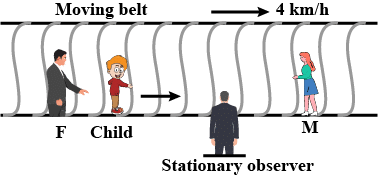
In this case,
Speed of belt w.r.t. ground
∴ vBG = 4kmh−1
Speed of child w.r.t. belt
∴ vCB = 9kmh−1
∴ For an observer on a stationary platform, speed of child running in the direction of motion of the belt is
vCG = vCB + vBG = 9kmh−1 + 4kmh−1
= 13kmh−1
On a two-lane road, car A is travelling with a speed of 36 km h-1. Two cars B and C approach car A in opposite directions with a speed of 54 km h-1 each. At a certain instant, when the distance AB is equal to AC, both being 1 km, B decides to overtake A before C does. The minimum required acceleration of car B to avoid an accident is- a)1 ms-2
- b)1.5 ms-2
- c)2 ms-2
- d)3 ms-2
Correct answer is option 'A'. Can you explain this answer?
On a two-lane road, car A is travelling with a speed of 36 km h-1. Two cars B and C approach car A in opposite directions with a speed of 54 km h-1 each. At a certain instant, when the distance AB is equal to AC, both being 1 km, B decides to overtake A before C does. The minimum required acceleration of car B to avoid an accident is
a)
1 ms-2
b)
1.5 ms-2
c)
2 ms-2
d)
3 ms-2
|
|
Ajay Yadav answered |
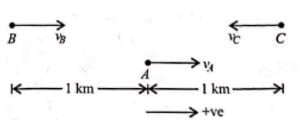
Velocity of car A ,

Velocity of car B ,

Velocity of car C ,
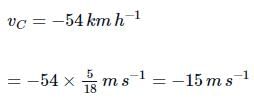
Relative velocity of car B w.r.t. car A
vBA = vB−vA = 15ms−1−10ms−1 = 5ms−1
Relative velocity of car C w.r.t. car A is
vCA = vC−vA = −15ms−1 − 10ms−1=−25ms−1
At a certain instant, both cars B and C are at the same distance from car A
i.e. AB − BC = 1km = 1000m
Time taken by car C to cover 1km to reach car A

In order to avoid an accident, the car B accelerates such that it overtakes car A in less than 40s. Let the minimum required acceleration be a. Then,



In order to avoid an accident, the car B accelerates such that it overtakes car A in less than 40s. Let the minimum required acceleration be a. Then,


The position of an object moving along x-axis is given by x = a + bt2, where a = 8.5 m and b = 2.5 m s−2 and t is measured in seconds. The instantaneous velocity of the object at t = 2 s- a)5 m s-1
- b)10 m s-1
- c)15 m s-1
- d)20 m s-1
Correct answer is option 'B'. Can you explain this answer?
The position of an object moving along x-axis is given by x = a + bt2, where a = 8.5 m and b = 2.5 m s−2 and t is measured in seconds. The instantaneous velocity of the object at t = 2 s
a)
5 m s-1
b)
10 m s-1
c)
15 m s-1
d)
20 m s-1
|
|
Preeti Iyer answered |
Here, x = a + bt2
Where, a = 8.5m and b = 2.5ms−2

At t = 2s,
v = 2(2.5ms−2)(2s) = 10ms−1
v = 2(2.5ms−2)(2s) = 10ms−1
Two cars A and B are running at velocities of 60 km h−1 and 45 km h−1. What is the relative velocity of car A with respect to car B, if car A is moving eastward and car B is moving westward?
- a)15 km h-1
- b)45 km h-1
- c)60 km h-1
- d)105 km h-1
Correct answer is option 'D'. Can you explain this answer?
Two cars A and B are running at velocities of 60 km h−1 and 45 km h−1. What is the relative velocity of car A with respect to car B, if car A is moving eastward and car B is moving westward?
a)
15 km h-1
b)
45 km h-1
c)
60 km h-1
d)
105 km h-1
|
|
Raghav Bansal answered |
Velocity of car A w.r.t. ground
∴ vAG = 60 kmh−1 as it is moving towards east
Velocity of car B w.r.t. ground
∴vBG = -45 km h−1 as it is moving towards west
Relative velocity of car A w.r.t. B
vAB = vAG - vBG
= 60 - (-45) = 60 + 45= 105 km h−1
Two towns A and B are connected by a regular bus service with a bus leaving in either direction every T minutes. A man cycling with a speed of 20 kmh-1 in the direction A to B notices that a bus goes past him every 18 min in the direction of his motion, and every 6 min in the opposite direction. The period T of the bus service is- a)4.5 min
- b)9 min
- c)12 min
- d)24 min
Correct answer is option 'B'. Can you explain this answer?
Two towns A and B are connected by a regular bus service with a bus leaving in either direction every T minutes. A man cycling with a speed of 20 kmh-1 in the direction A to B notices that a bus goes past him every 18 min in the direction of his motion, and every 6 min in the opposite direction. The period T of the bus service is
a)
4.5 min
b)
9 min
c)
12 min
d)
24 min
|
|
Ananya Das answered |
Let vkmh−1 be the constant speed with which the bus travel ply between the towns A and B .
Relative velocity of the bus from A to B with respect to the cyclist = (v − 20)kmh−1
Relative velocity of the bus from B to A with respect to the cyclist = (v + 20)kmh−1
Distance travelled by the bus in time T (minutes) = vT
As per question

Equating (i) and (ii) , we get
= 18v − 18 x 20 = 6v + 20 × 6
or 12v = 20 x 6 + 18 x 20 = 480 or v = 40 kmh−1
Putting this value of v in (i) , we get
40T = 18 x 40 − 18 x 20 = 18 x 20

A jet airplane travelling at the speed of 500kmh−1 ejects its products of combustion at the speed of 1500kmh−1 relative to the jet plane. The speed of the products of combustion with respect to an observer on the ground is- a)500 km h-1
- b)1000 km h-1
- c)1500 km h-1
- d)2000 km h-1
Correct answer is option 'B'. Can you explain this answer?
A jet airplane travelling at the speed of 500kmh−1 ejects its products of combustion at the speed of 1500kmh−1 relative to the jet plane. The speed of the products of combustion with respect to an observer on the ground is
a)
500 km h-1
b)
1000 km h-1
c)
1500 km h-1
d)
2000 km h-1
|
|
Hansa Sharma answered |
Veloity of jet plane w.r.t ground vjG = 500 km h-1
Velocity of products of combustion w.r.t jet plane vCJ = -1500 kmh-1
∴ Velocity of products of combustion w.r.t ground is vCG = vCJ + vJG = - 1500kmh-1 + 500 kmh-1
= -1000 km h-1
-ve sign shows that the direction of products of combustion is opposite to that of the plane
∴ Speed of the products of combustion w.r.t ground = 1000 km h-1
Velocity of products of combustion w.r.t jet plane vCJ = -1500 kmh-1
∴ Velocity of products of combustion w.r.t ground is vCG = vCJ + vJG = - 1500kmh-1 + 500 kmh-1
= -1000 km h-1
-ve sign shows that the direction of products of combustion is opposite to that of the plane
∴ Speed of the products of combustion w.r.t ground = 1000 km h-1
The speed-time graph of a particle moving along a fixed direction is shown in Fig. Obtain the distance traversed by the particle between time t = 0 s to 10 s.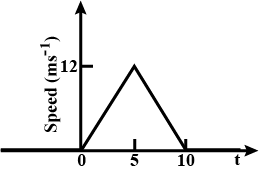
- a)20 m
- b)40 m
- c)60 m
- d)80 m
Correct answer is option 'C'. Can you explain this answer?
The speed-time graph of a particle moving along a fixed direction is shown in Fig. Obtain the distance traversed by the particle between time t = 0 s to 10 s.

a)
20 m
b)
40 m
c)
60 m
d)
80 m
|
|
Jyoti Sengupta answered |
Distance = Area under speed-time graph over a given time interval.
∴ Distance traversed by the particle between t = 0 s to t = 10 s will be

The figure shows the x−t plot of a particle in one-dimensional motion. Two different equal intervals of time are shown. Let v1 and v2 be speed in time intervals 1 and 2 respectively. Then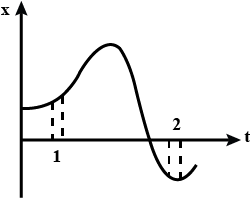
- a)v1 > v2
- b)v2 > v1
- c)v1 = v2
- d)Data is insufficient
Correct answer is option 'A'. Can you explain this answer?
The figure shows the x−t plot of a particle in one-dimensional motion. Two different equal intervals of time are shown. Let v1 and v2 be speed in time intervals 1 and 2 respectively. Then

a)
v1 > v2
b)
v2 > v1
c)
v1 = v
2
d)
Data is insufficient
|
|
Preeti Iyer answered |
The average speed in a small interval of time is equal to the slope of x-t graph during that interval. As slope of interval 1> slope of interval 2
∴ v1 > v2
In the given v-t graph the distance traveled by the body in 5 seconds will be 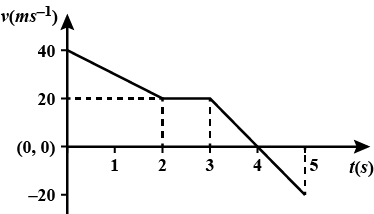
- a)100 m
- b)80 m
- c)40 m
- d)20 m
Correct answer is option 'A'. Can you explain this answer?
In the given v-t graph the distance traveled by the body in 5 seconds will be

a)
100 m
b)
80 m
c)
40 m
d)
20 m
|
|
Ananya Das answered |
The distance is equal to total area under v-t graph

The displacement-time graph of a moving particle is shown below. The instantaneous velocity of the particle is negative at the point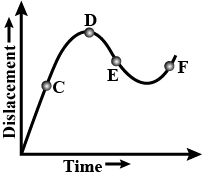
- a)C
- b)D
- c)E
- d)F
Correct answer is option 'C'. Can you explain this answer?
The displacement-time graph of a moving particle is shown below. The instantaneous velocity of the particle is negative at the point

a)
C
b)
D
c)
E
d)
F
|
|
Preeti Iyer answered |
The slope of the tangent at any point on the displacement-time graph gives instantaneous velocity at that instant. In the given graph, the slope is negative at point E.
A 175m long train is travelling along a straight track with a velocity 72km−1h. A bird is flying parallel to the train in the opposite direction with a velocity 18km−1h. The time taken by the bird to cross the train is- a)35 s
- b)27 s
- c)11.6 s
- d)7 s
Correct answer is option 'D'. Can you explain this answer?
A 175m long train is travelling along a straight track with a velocity 72km−1h. A bird is flying parallel to the train in the opposite direction with a velocity 18km−1h. The time taken by the bird to cross the train is
a)
35 s
b)
27 s
c)
11.6 s
d)
7 s

|
Infinity Academy answered |
The bird and train are moving in opposite directions, so their relative speed is the sum of their speeds: (72 km/h + 18 km/h) = 90 km/h.
Converting this speed into meters per second, we get 90 km/h = 25 m/s in SI units.
The train is 175 meters long. To find the time taken by the bird to cross the train, we use the formula: Time = Distance/Speed.
Thus, Time = 175 m / 25 m/s = 7 seconds.
A ball A is thrown up vertically with a speed u and at the same instant another ball B is released from a height h. At time t, the speed of A relative to B is- a)u
- b)u - 2gt
- c)

- d)2u
Correct answer is option 'A'. Can you explain this answer?
A ball A is thrown up vertically with a speed u and at the same instant another ball B is released from a height h. At time t, the speed of A relative to B is
a)
u
b)
u - 2gt
c)

d)
2u
|
|
Ananya Das answered |
Taking upwards motion of ball A for time t, its velocity is VA = U - gt.
Taking downwards motion of ball B for time, its velocity is VB = gt.
Relative velocity of A w.r.t. B
=VAB = VA -(-VB) = (u - gt) - (-gt) = u
Taking downwards motion of ball B for time, its velocity is VB = gt.
Relative velocity of A w.r.t. B
=VAB = VA -(-VB) = (u - gt) - (-gt) = u
A car is moving along a straight line OP as shown in the figure. It moves from O to P in 18 s and returns from P to Q in 6 s. Which of the following statements is not correct regarding the motion of the car?

- a)The average speed of the car in going from O to P and come back to Q is 20 ms-1
- b)The average velocity of the car in going from O to P and come back to O is 0 ms-1
- c)The average speed of the car in going from O to P is 20 ms-1
- d)The average velocity of the car in going from O to P and come back to Q is 20 ms-1
Correct answer is option 'D'. Can you explain this answer?
A car is moving along a straight line OP as shown in the figure. It moves from O to P in 18 s and returns from P to Q in 6 s. Which of the following statements is not correct regarding the motion of the car?

a)
The average speed of the car in going from O to P and come back to Q is 20 ms-1
b)
The average velocity of the car in going from O to P and come back to O is 0 ms-1
c)
The average speed of the car in going from O to P is 20 ms-1
d)
The average velocity of the car in going from O to P and come back to Q is 20 ms-1
|
|
Raghav Bansal answered |

From O to P and back to Q


From O to P and come back to O

The position-time (x - t) graphs for two children A and B returning from their school O to their homes P and Q respectively are as shown in the figure. Choose the incorrect statement regarding these graphs.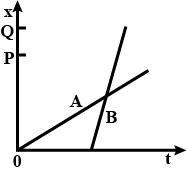
- a)A lives closer to the school than B
- b)A starts from the school earlier than B
- c)A walks faster than B
- d)A and B reach home at the same time
Correct answer is option 'C'. Can you explain this answer?
The position-time (x - t) graphs for two children A and B returning from their school O to their homes P and Q respectively are as shown in the figure. Choose the incorrect statement regarding these graphs.

a)
A lives closer to the school than B
b)
A starts from the school earlier than B
c)
A walks faster than B
d)
A and B reach home at the same time
|
|
Gaurav Kumar answered |
As OP < OQ, A lives closer to the school than B.
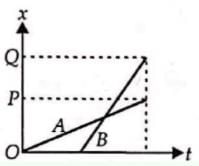
(b) For x = 0, t = 0 for A; while t has some finite value for B. Therefore,
A starts from the school earlier than B.
(c) Slope of x - t graph is equal to the speed. Since the slope of x-t for B is greater than that for A. Therefore, B walks faster than A.
(d) Corresponding to points P and Q the value of t from x - t graphs for A and B is same. Thus, both A and B reach home at the same time.
Chapter doubts & questions for Position-Time Graphs - Physics 2025 is part of Grade 9 exam preparation. The chapters have been prepared according to the Grade 9 exam syllabus. The Chapter doubts & questions, notes, tests & MCQs are made for Grade 9 2025 Exam. Find important definitions, questions, notes, meanings, examples, exercises, MCQs and online tests here.
Chapter doubts & questions of Position-Time Graphs - Physics in English & Hindi are available as part of Grade 9 exam.
Download more important topics, notes, lectures and mock test series for Grade 9 Exam by signing up for free.
Physics
307 videos|482 docs|202 tests
|

Contact Support
Our team is online on weekdays between 10 AM - 7 PM
Typical reply within 3 hours
|
Free Exam Preparation
at your Fingertips!
Access Free Study Material - Test Series, Structured Courses, Free Videos & Study Notes and Prepare for Your Exam With Ease

 Join the 10M+ students on EduRev
Join the 10M+ students on EduRev
|

|
Create your account for free
OR
Forgot Password
OR
Signup to see your scores
go up within 7 days!
Access 1000+ FREE Docs, Videos and Tests
Takes less than 10 seconds to signup


